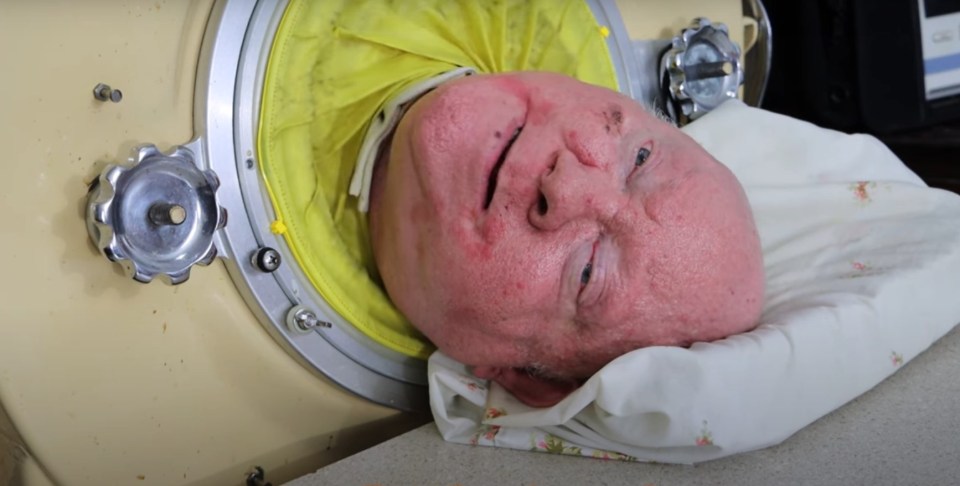PAUL Alexander – the man who lived in an iron lung for 70 years – has died at the age of 78.
Widely known as Polio Paul, he was left paralysed after suffering polio in 1952 when he was six years old.
YouTube/ SBSKPolio Paul has died at the age of 78[/caption]
YouTube/SBSKHe was kept alive in a 7ft iron lung for decades[/caption]
After coming back from playing outside with a fever and headache that summer, the deadly virus took hold within a few days and Paul, from Texas, was rushed to hospital.
Doctors operated on him to clear the mucus that had filled his lungs because his body was unable to clear it.
When he woke up he was in the mechanical contraption — where he would spend the majority of his life.
Paul survived in the machine for seven decades, but an update on Tuesday on his GoFundMe page revealed he died on Monday.
It reads: “Paul Alexander, “The Man in the Iron Lung”, passed away yesterday.
“After surviving polio as a child, he lived over 70 years inside of an iron lung.
“In this time Paul went to college, became a lawyer, and a published author.
“His story traveled wide and far, positively influencing people around the world.
“Paul was an incredible role model that will continue to be remembered.
“Paul, you will be missed but always remembered.”
Polio is a deadly virus that attacks the spinal cord, leaving some survivors paralysed.
It caused annual epidemics through the early 1900s to 1950s, causing tens of thousands of children to lose the use of their limbs each year in the US and Europe.
Symptoms include a high temperature, tiredness, headaches, vomiting a stiff neck and muscle pain.
Many affected children had to be put in iron lungs — 7ft metal cases that use a vacuum to push air in and out of their own lungs.
A vaccine was invented in 1955, largely wiping out the virus and protecting people against it.
But the vaccine came too late for Paul, who was left unable to move from the neck down.
He had a team of rotating carers to clean and look after him, and used his mouth to manipulate a pen when writing or using a phone.
What is polio?
POLIO is an infectious disease that can spread from person to person and most commonly affects children under the age of five.
The disease attacks the nervous system and in some extreme cases can lead to paralysis.
Polio is very contagious, and a person can transmit it even when they aren’t sick.
There are two ways the virus goes from person to person.
The first is that people with poliovirus in their bodies shed the virus through their faeces.
The second way is the virus can then spread to other people when they swallow contaminated water or food.
This exposure is more likely in areas that have poor hygiene or weak systems to clean water.
Polio is caused by a virus called poliovirus.
The virus enters the body through the mouth or nose, getting into the digestive and respiratory (breathing) systems.
It then harvests in the throat and intestines.
From there, it can enter the bloodstream and attack the nervous system.
There are three strains of poliovirus: types one, two, and three. Types two and three have been eliminated, but type one still affects people in a few countries.
Although there is no cure, there is a safe and effective vaccine.
Despite more modern ventilators existing since the 1960s, Paul decided to continue using the iron lung because it was what he was used to.
Other devices can also require a tracheostomy — a hole in the throat — which he never wanted again, after having to have one initially when he was first struck with the virus.
He lived in the hospital for two years but went on to finish high school, graduate from university with a law degree and practice law for decades.
Paul learnt a technique called frog breathing, which allows people to gulp air down with their throat instead of using their lungs, which gave him short periods outside the device.
He represented clients in court wearing a three-piece suit in a wheelchair that held his body upright.
But as he aged, he had been confined to the device, and lived at a facility in Dallas.
Many well-wishers have continued donating to Paul’s GoFundMe page to help contribute to his funeral.
His brother Philip said: “I am so grateful to everybody who donated to my brother’s fundraiser.
“It allowed him to live his last few years stress-free. It will also pay for his funeral during this difficult time.
“It is absolutely incredible to read all the comments and know that so many people were inspired by Paul.”

